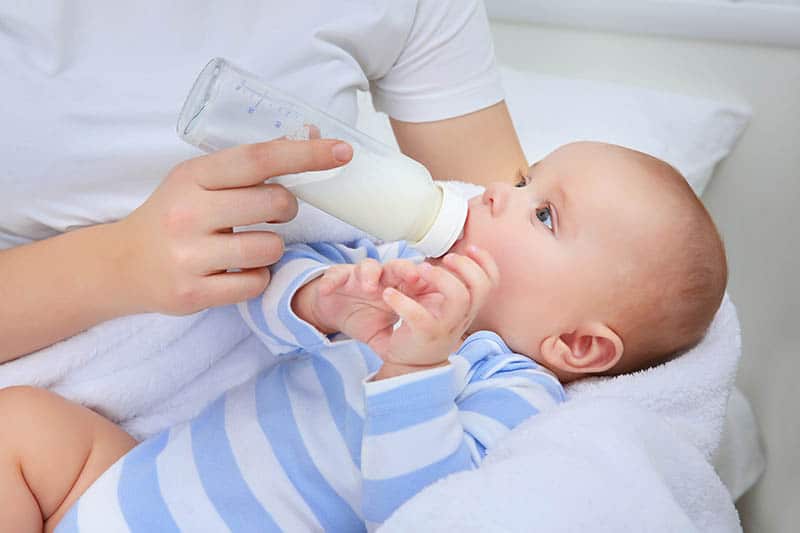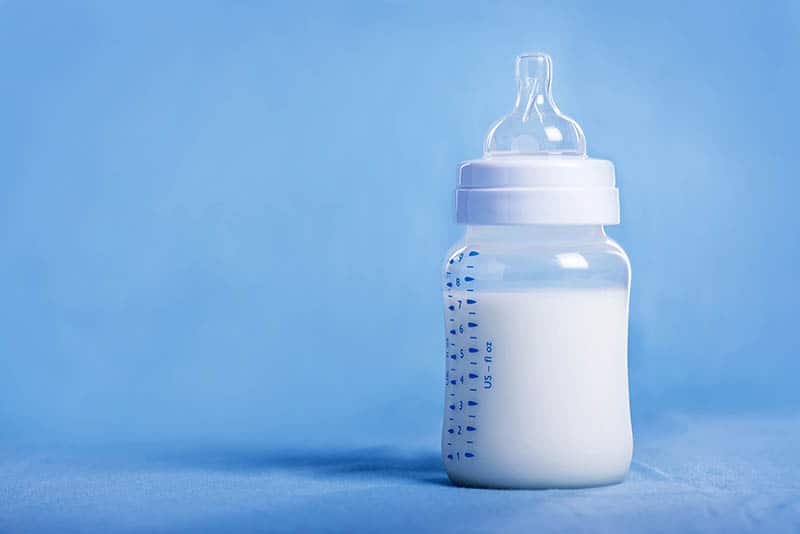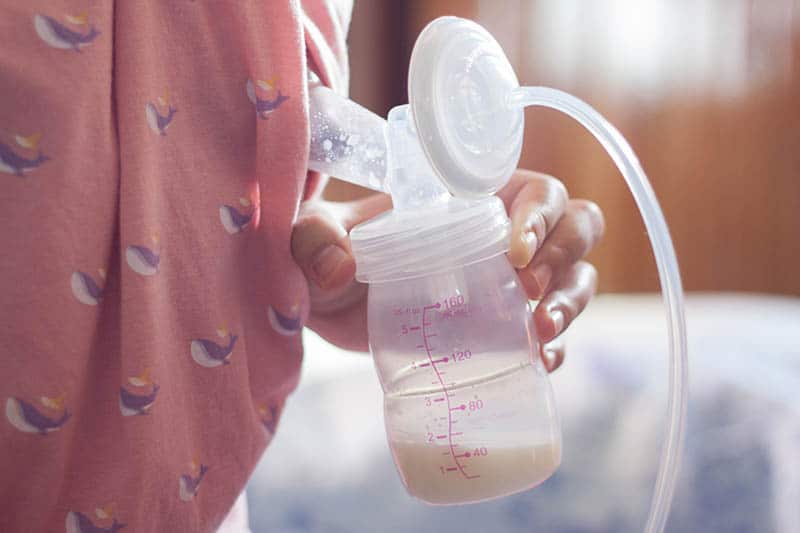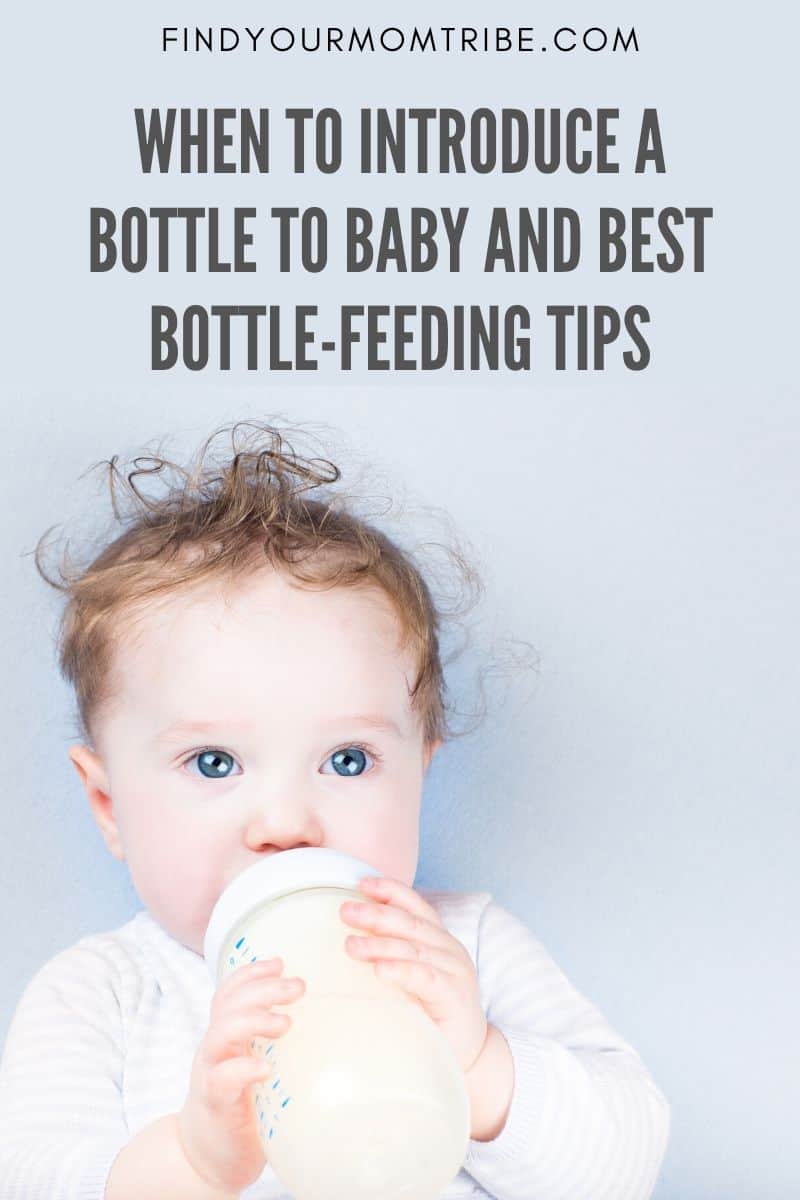For moms who breastfeed, the question of when to introduce a bottle to their breastfeeding baby is very important, especially if mom is expecting to go to work soon and another caregiver will have to feed the baby.
On the other hand, introducing a bottle to the baby is more than just a matter of maternity leave.
Having a baby who is fully dependent on you for feedings can limit your freedom and opportunities to do things on your own from time to time.
And even though your little one needs lots of love and care right now, so do you, mama!
That’s why giving your baby their very first bottle is a significant step.
To make sure that introducing a bottle to breastfed baby goes successfully, we will go over the most important guidelines to follow, so that your baby takes to being bottle-fed as quickly as possible!
When To Introduce A Bottle To A Breastfed Baby

But before you start considering bottles, you should first make sure that your baby is breastfeeding successfully – that means having a good latch and getting enough milk from feedings.
Giving a bottle too early can cause the baby to start rejecting breastfeeding altogether, while offering the bottle too late can lead to bottle refusal – so you can see why striking the perfect balance between not too soon and not too late is important.
According to the La Leche League, the best time to start is when the baby is one month old and is feeding well from the breast.
Avoiding pacifiers during this time is also advisable.
Around the one-month mark the baby’s sucking reflex will encourage them to suck on anything that is put in their mouth, which will definitely play into your favor!
If your newborn still needs some time to get the hang of breastfeeding, you don’t need to rush it but remember that waiting too long isn’t advisable either – your lactation consultant can help you develop a timeframe for your little one.
Remember not to offer the bottle too often to your little one – around four times a week will be enough and will strike the right balance between bottles and your breasts.
How To Do It Right

Maybe you’ve heard plenty of horror stories from fellow moms who struggled for weeks to get their baby used to the feel of an artificial nipple in their mouth, meaning that you are now hesitant to even try.
While it is true that some babies are slower to take to a bottle than others, expecting a negative outcome right off the bat is not the kind of attitude you should have when introducing bottles for the first time.
It goes without saying that you should be patient and listen to your baby’s cues – pushing ahead when your little one is clearly rejecting the bottle can only cause more harm.
Like the breastfeeding experience, bottle feedings should be pleasant for your baby and you should aim to create a comfortable atmosphere when bringing it out for the first time.
In addition, there is no need for the baby to have a full feed the first few times you offer the bottle, just express a few sips of milk into the bottle.
Preparing the bottle is also very important and will minimize the chances of the baby rejecting it – and by preparing, I’m talking about warming the bottle and the nipple before it reaches the baby’s lips.
Just think about it – mom’s nipples aren’t cold (and neither is her milk), so make sure to soak the silicone or rubber nipple in a bit of warm water for a few minutes to make sure it’s not too cold.
Don’t forget to warm the milk, too, as there is a big chance that the baby won’t like the taste of cold milk.
You’re probably curious about what the right time of day is to try bottle-feeding.
While there is no specific rule here (after all, you know your baby best!) it’s quite helpful to offer it right after the baby wakes up and isn’t as alert as usual.
Alternatively, you can try it when you start noticing your little one is getting hungry but don’t wait until they’re cranky from hunger.
Another way to “sneak in” a bottle is to do it halfway through a nursing session.
If your little one is being a bit resistant, then maybe it’s time to let someone else offer the bottle instead of you.
I know that this may be hard, after all, you’ve been the one providing all the nutrition for your baby since they were born, so letting go of this special experience might not be so easy.
On the other hand, you should realize that some babies don’t care to feed from a bottle when they’re in their mama’s comforting arms.
This is a perfect opportunity to let your partner (or another family member) try a bottle feed and bond with the baby.
You can do this when both of you are at home, just make sure not to be in the same room as the baby.
But you can also take this opportunity to leave the house for an hour or two, take a walk or grab a nice bite to eat and relax.
If the baby absolutely refuses the bottle while being held by someone else, they can try using a shirt you have already worn and place it on their arm, chest, or anywhere the baby can smell it.
Your scent can soothe your baby and help them relax enough to give the bottle a chance.
In addition, remember that just because drinking milk from a baby bottle is easier than from a breast, doesn’t mean that there isn’t a bit of a technique involved when offering it for the first time.
So, whether you or another caregiver is doing it, having the baby in a slightly upright position is important so that they don’t get used to drinking from a bottle while laying down.
Tilt the bottle just enough for the nipple to fill up but don’t hold it up vertically, as this will ensure a slower milk flow that is closer to your own.
This prevents future tooth decay and ear infections, as well. Plus, your baby won’t be overwhelmed by the sudden rapid flow of milk.
Gently stroke the nipple against the baby’s lips, which will cause the baby to open their mouth wide in a gape.
You can even squeeze a few drops out so that the baby knows what to expect and that the strange silicone nipple is actually a way to get some milk!
When the baby opens their mouth, place the nipple in their mouth (not just the tip) and hopefully, the baby will take to it and start feeding.
If this doesn’t happen, you can try again but don’t turn it into a frustrating experience for the baby. Limit it to 10 minutes and if you have no success, you can make another attempt tomorrow.
Remember – when we talk about introducing a bottle, we talk about a process.
And even though you probably know a mom whose baby accepted it like it was no big deal, that doesn’t mean your boy or girl will be the same or get used to it at the same pace.
Once your baby is used to feeding this way, make sure to watch for other signs that could indicate that the feedings are going well.
For example, if your little one is turning away from the bottle, is coughing or gulping, this is a sign that the flow of the milk is too fast.
But if the baby seems to be getting fussy or frustrated even though they are sucking on the nipple, this is a good indication that you should move up a nipple size.
Finding The Right Bottle

In fact, many mamas have discovered that while one brand of bottles didn’t work, another did.
This doesn’t mean that you should switch bottles every other day but if you do see that your baby is simply not responding to one brand, you can try switching it for another.
One of the most important parts of the bottle is the actual nipple – it should be a slow flow nipple that lets down milk at a speed that’s similar to your own.
In addition, a slower flow will prevent your baby from developing a preference for the bottle right off the bat.
There are even nipples that are specially designed with premature babies in mind but even a baby that was carried to term can use it during the period when they’re learning how to feed from a bottle.
When we talk about bottles specifically, there are brands that have a very wide shape, which some babies find to be similar to their mommy’s breast.
Besides, these models are much easier to hand wash, so they’re practical, too.
In addition, some are completely made from soft silicone, making them soft to the touch, so the baby can squeeze them while feeding.
Then again, brands that have a standard, narrow shape can work just as well, meaning that it’s not a bad idea to purchase one of each shape to see how your baby responds to the different bottles.
Ask your mom friends which brands they have had luck with and I’m sure you will get plenty of amazing recommendations!
If your little one has a tendency to get gassy or spits up often, make sure to get a brand that is able to keep extra air out, otherwise the bottle might not agree with your baby’s digestive system.
Should I Worry About Nipple Confusion?

For every person that claims this phenomenon is a load of baloney, there is one that claims it’s very real. So, what is it exactly?
Nipple confusion occurs when a baby is exposed to a bottle too early, for example, and develops a clear preference for bottle feedings.
In this case, “confusion” is probably not the best word to explain this occurrence because the baby just prefers a bottle.
After all, sucking milk out of a bottle is much easier than out of a breast, because gravity does almost all of the work!
On the other hand, some babies start having trouble with latching at the breast properly after being fed through a bottle.
This is because a bottle teat requires a different kind of sucking than a breast, which causes confusion.
That being said, you will definitely find many new parents who had no trouble with nipple confusion, and their babies happily switch between the two.
Not to mention that there are numerous babies who are fed breast milk and formula, and are doing great!
How To Start Pumping

While some moms get the knack of pumping in the early days, especially if they need to keep their milk flowing while their baby gets used to breastfeeding, some don’t need to pump until they’re ready to introduce the bottle to their baby.
Even though electric breast pumps can seem a bit complicated at first, you will quickly get the hang of them and will be stocking up on milk in no time!
If you’re planning on going back to work, you should plan on starting to use your breast pump about three weeks prior to the end of your maternity leave.
This will not only give you enough time to build up a supply of milk but also plenty of time to slowly start feeding baby from a bottle so that by the time you’re back in the office, your little one will have learned this new skill.
As your baby boy or girl is already on a nursing schedule, it’s important to figure out when to work pumping into your day without jeopardizing the amount of milk your baby gets.
Here are some ways you can incorporate pumping milk into your schedule:
- While the baby is nursing on one breast, attach a breast pump to the other. This method will completely drain both breasts, ensuring that you have a good supply of milk.
- Pump milk in the morning, an hour or two after your baby has had their feeding.
- You can also pump right after feedings to make sure both breasts are fully drained.
To Wrap Up
As you try to decide when to introduce a bottle to your baby, remember not to get stressed over it too much!
As moms, we tend to dig up all the horror stories and completely forget that sometimes things go just fine.
That doesn’t mean that you should dive headfirst into this new chapter completely unprepared – you should at least be mindful of how old your baby is and how well they have adjusted to nursing, as a lack of preparation in this aspect could cause your baby to develop a preference for the bottle.
Sooner or later, your precious bundle of joy will have adapted to this new way of feeding and you will be able to go back to work and get some of your personal time back to have fun with your friends and focus on self-care!
References:
“Introducing a Bottle to a Breastfed Baby” published by the La Leche League International on the La Leche League International website.
Like this post? Please share or pin it for later. You can also stay in the loop and follow us on Facebook, Instagram or Pinterest.

This post contains affiliate links. Please see our full disclosure for more info.

